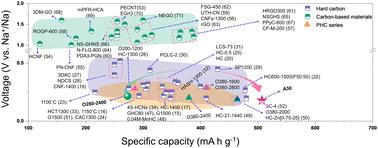当前位置:
X-MOL 学术
›
Energy Environ. Sci.
›
论文详情
Our official English website, www.x-mol.net, welcomes your feedback! (Note: you will need to create a separate account there.)
Design guidelines for a high-performance hard carbon anode in sodium ion batteries
Energy & Environmental Science ( IF 32.5 ) Pub Date : 2024-03-26 , DOI: 10.1039/d4ee00315b Jong Chan Hyun 1 , Hyeong Min Jin 2, 3 , Jin Hwan Kwak 4 , Son Ha 1 , Dong Hyuk Kang 1 , Hyun Soo Kim 1 , Sion Kim 1 , Minhyuck Park 1 , Chan Yeol Kim 1 , Juhee Yoon 5 , Ji Sung Park 2, 3 , Ji-Young Kim 6 , Hee-Dae Lim 7 , Se Youn Cho 8 , Hyoung-Joon Jin 5 , Young Soo Yun 1, 4, 9
Energy & Environmental Science ( IF 32.5 ) Pub Date : 2024-03-26 , DOI: 10.1039/d4ee00315b Jong Chan Hyun 1 , Hyeong Min Jin 2, 3 , Jin Hwan Kwak 4 , Son Ha 1 , Dong Hyuk Kang 1 , Hyun Soo Kim 1 , Sion Kim 1 , Minhyuck Park 1 , Chan Yeol Kim 1 , Juhee Yoon 5 , Ji Sung Park 2, 3 , Ji-Young Kim 6 , Hee-Dae Lim 7 , Se Youn Cho 8 , Hyoung-Joon Jin 5 , Young Soo Yun 1, 4, 9
Affiliation

|
Unclear information on materials design significantly hinders the construction of enhanced hard carbon anodes with high sodium plateau capacities (SPCs). The pore volume ratio of hard carbon imposes thermodynamic limitations on the theoretical sodium plateau capacities (T-SPCs); however, relying solely on its pore structures is not sufficient to predict the practicable SPCs. This study entailed an investigation of a key kinetic parameter of hard carbons that mainly affects the coefficient of capacity utilization (CCU) of SPCs by using a series of polymeric hard carbons (PHCs) with different microstructures. A systematic study revealed a close relationship between the 2D to G band intensity ratio (I2D/IG) in the Raman spectrum and the internal kinetic barrier for sodium-ion transfer. On the basis of the thermodynamic and kinetic parameters, the structural indicator referred to as the SPC factor was devised to characterize the CCU for SPCs. The SPC factor clearly describes an optimal hard carbon anode as one that possesses a high closed pore volume ratio and low I2D/IG value. The highest SPC of ∼400 mA h g−1 was achieved through simple microstructural tuning of the PHCs, demonstrating the feasibility of the proposed design guidelines for a high-performance hard carbon anode for sodium-ion batteries.
中文翻译:

钠离子电池高性能硬碳阳极设计指南
材料设计的不明确信息极大地阻碍了具有高钠平台容量(SPC)的增强型硬碳阳极的构建。硬碳的孔体积比对理论钠平台容量(T-SPC)施加热力学限制;然而,仅依靠其孔隙结构不足以预测实用的 SPC。本研究通过使用一系列具有不同微观结构的聚合硬碳(PHC)对硬碳的一个关键动力学参数进行了研究,该参数主要影响SPC的容量利用率(CCU)。系统研究揭示了拉曼光谱中 2D 与 G 带强度比 ( I 2D / I G ) 与钠离子转移的内部动力学势垒之间的密切关系。在热力学和动力学参数的基础上,设计了称为SPC因子的结构指标来表征SPC的CCU。 SPC 因子清楚地将最佳硬碳阳极描述为具有高闭孔体积比和低I 2D / I G值的阳极。通过PHC的简单微观结构调整实现了~400 mA hg -1的最高SPC ,证明了所提出的钠离子电池高性能硬碳阳极设计指南的可行性。
更新日期:2024-03-26
中文翻译:

钠离子电池高性能硬碳阳极设计指南
材料设计的不明确信息极大地阻碍了具有高钠平台容量(SPC)的增强型硬碳阳极的构建。硬碳的孔体积比对理论钠平台容量(T-SPC)施加热力学限制;然而,仅依靠其孔隙结构不足以预测实用的 SPC。本研究通过使用一系列具有不同微观结构的聚合硬碳(PHC)对硬碳的一个关键动力学参数进行了研究,该参数主要影响SPC的容量利用率(CCU)。系统研究揭示了拉曼光谱中 2D 与 G 带强度比 ( I 2D / I G ) 与钠离子转移的内部动力学势垒之间的密切关系。在热力学和动力学参数的基础上,设计了称为SPC因子的结构指标来表征SPC的CCU。 SPC 因子清楚地将最佳硬碳阳极描述为具有高闭孔体积比和低I 2D / I G值的阳极。通过PHC的简单微观结构调整实现了~400 mA hg -1的最高SPC ,证明了所提出的钠离子电池高性能硬碳阳极设计指南的可行性。



























 京公网安备 11010802027423号
京公网安备 11010802027423号